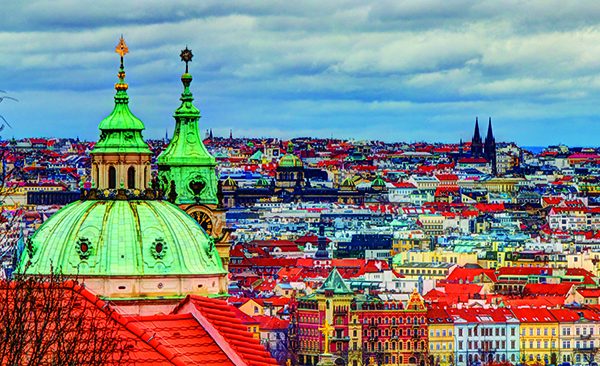Prague: Czech It Out

Yvonne Wright is an Emmy-award-winning journalist who is a connoisseur…
I foresee a city whose fame touches the stars!” Bohemian Duchess Libuše said in the 12th century, just before her kingdom began work on what is now one of the most beautiful cities in the world.
Known as the “City of a Hundred Spires,” Prague combines Medieval, Gothic, Renaissance, and Baroque architecture. Narrow lanes of humble, broken-cobblestone streets hold the majestic Prague Castle that has been home to royal, religious, communist, and democratic leaders.
Bisected by the Vltava River, the city is cut in half. Lesser Town sits on the left bank. Here, you’ll find the castle and some of the most beautiful Baroque churches in the world. The right bank is home to Old Town and the Jewish Quarter. Connecting it all: the massive 15th-century stone Charles Bridge. Draped with ancient statues, towers on either side provide tourists an opportunity to see the city from above.
For centuries, members of the upper classes have walked these streets side-by-side with some of the nation’s poorest citizens. It’s a city steeped in history, in conflict, and in peace.
I’ve had the pleasure of visiting both the Communist-controlled Prague and the democratic one. I can say it is far, far more easy to travel there today. Many people now speak English. Hotels, hostels, and cafes are open to everyone. And taxis are now available. That may not seem like big deal, but get lost in a city with street signs that each contain upwards of 10 connecting consonants and no one — no one — who speaks English.
I first visited the Czech Republic’s capital in the 80s when it was still Czechoslovakia. Traveling alone meant I had to stay in a government-run apartment, check in daily at the police station, and ride the city trolleybus that I thought was free until one day a member of the communist party stood up and began lecturing me in Czech (one of the most difficult languages for an English speaker to understand). Back then, members of the party were everywhere, dressed as civilians, making sure rules were followed. Apparently, I was supposed to put money into a cup on the unmanned trolleybus. (I thought it was a tip jar).
One thing remains the same: The people are among the kindest in the world. In the 80s, the curator of the Lenin museum was called in to personally meet the American claiming to be a communist (yes, that would be me in my youth). I was showered with gifts of Lenin pins and hammer-and-sickle keychains.
When I first arrived, I was taken off the train in the middle of the night by armed soldiers because I lost my visa. Heart pounding, hands quivering, I was ushered into a small, concrete building. Imagine my relief when I saw the inside was painted with peace signs and white doves. The guard who spent an entire night fixing my visa personally drove me to the city in his teeny, tiny car. He didn’t speak English, but animatedly yelled the names of famous Czechoslovakian tennis players as we passed grass-covered courts.
This generous spirit remains, even as foreigners pounce on the city — opening English speaking newspapers, businesses, and cafes. There are now designer fashion shows in a city that once dressed 20 years behind the times. Bars are now open all night (I don’t know what Russia had against late drinkers). What hasn’t changed is the intimacy and personal service found inside these small pubs carved into ancient stone structures. You’ll also find English menus now. In the 80s, I had to guess and point. One night I ended up with a raw egg on top of a raw steak. Not eating in a country with so little food is insulting. I’m afraid I probably insulted someone that night.
Most historic sites are open to tourists. Churches and some historic landmarks are free. You can also catch an opera, ballet, or concert at one of the many beautiful venues. My favorite activity is grabbing a kielbasa from one of the sausage stands and meandering through the streets.
Getting around is easy. The subway, buses, and trams are conveniently located. The city itself is also very walkable. A word of warning, though, about those convenient taxis I mentioned earlier: Only take official cabs with a yellow roof lamp permanently installed. Private taxi drivers are notoriously shady.
I suggest going during the off season (anytime that is not summer). The city is becoming more and more crowded as word of its beauty spreads west. It is, after all, a city whose fame touches the sky.
What's Your Reaction?
Yvonne Wright is an Emmy-award-winning journalist who is a connoisseur of great literature and mediocre TV.




